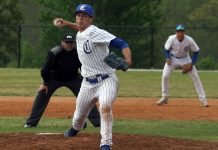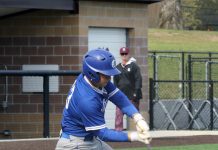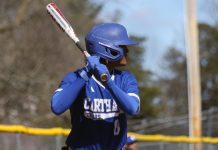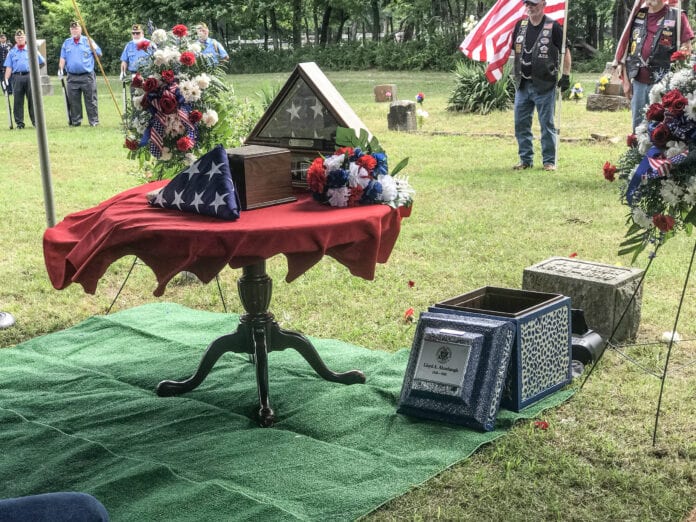

REEDS, Mo. — June 25, 2021 marked 71 years since the start of the Korean War, when soldiers from North Korea crossed the border and invaded the south.
That was also the day an American soldier killed in that war returned home to Reeds to be buried between his mom and dad.
Accompanied by motorcycle riders with the Combat Veterans Motorcycle Association 4-9, Joplin, and dozens of well-wishers, the hearse carrying the remains of Sgt. Lloyd A. Alumbaugh left Ulmer Funeral Home in Carthage and traveled on Fir Road to a tiny, quiet cemetery just north of Reeds where more than 100 well-wishers helped lay to rest a man who died in combat on a frozen, mountainous battlefield almost 6,500 miles from his home and more than 70 years ago.
Alumbaugh was last seen alive on Nov. 28, 1950 with his unit near the Chosin Reservoir in northern North Korea as soldiers prepared for what they hoped was one of the final pushes that would knock the Communist North out of the war and let them go home by Christmas.
An eye witness told family members in the 1990s that Alumbaugh, who was an ambulance driver and medic with the U.S. Army’s 7th Infantry Division, was killed when his ambulance was hit and blown up in a surprise attack by Chinese soldiers at the beginning of the famous battle of the Chosin Reservoir.
All five of Alumbaugh’s brothers and sisters died before he was found, although blood samples from Lloyd Alumbaugh’s sister, Mary Meyer, and brother, James Alumbaugh, collected in 1993 by the Army provided the DNA needed to identify the fragmented remains.
“It might shock you, but until now, recently, no one could go to find the bodies, the missing parts of the soldiers. Until, and you might not even like to hear this, Donald J. Trump,” said Chaplain Ron Boldman, who officiated at the graveside service. “He went and met with Kim Jong Un in Singapore and said I want the bodies back, and he agreed and sent 55 boxes of remains. Lloyd was one of them they could find (using DNA) from his sister, Mary, and his brother.
“So it’s been a long, long struggle. No one likes to lose their loved one and no one likes to sit and wait, and a chaplain, no chaplain likes to go to a home to inform the parents that their children have either been killed or missing in action. But he’s home.”
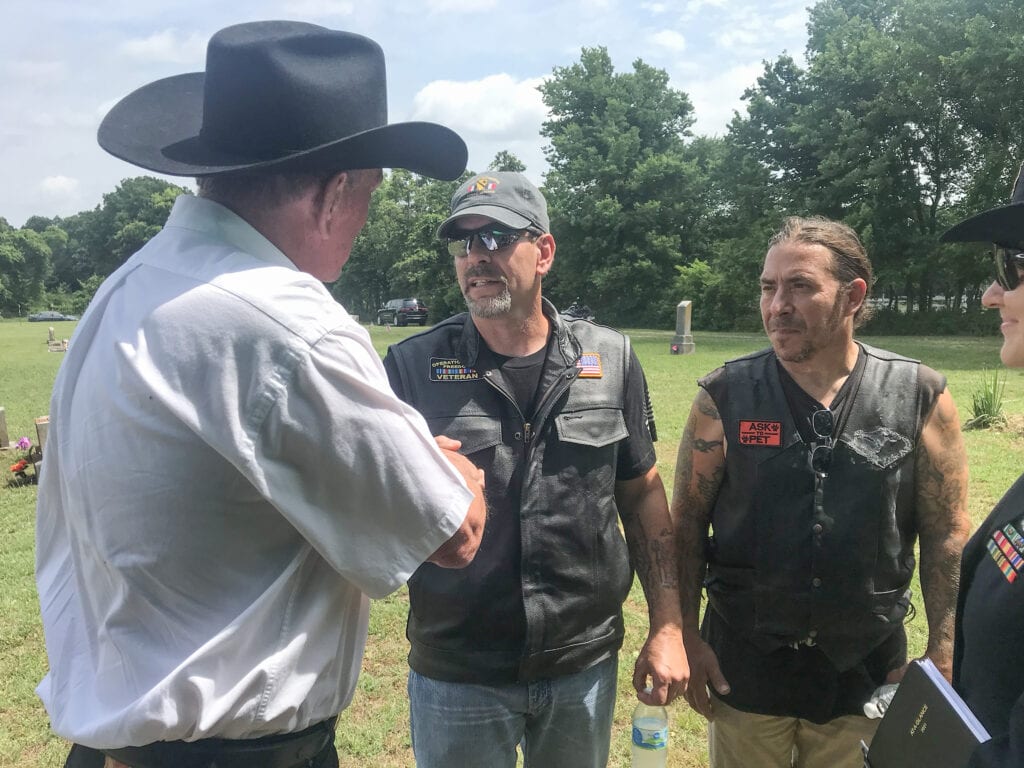
Family memories
Few people remain who can say they met Lloyd Alumbaugh before he enlisted in the Army in 1948 and shipped out for Korea in 1950.
Wes Alumbaugh, Carthage, a nephew and the oldest living relative of Lloyd Alumbaugh, said he was a year and a half old when his uncle went missing in Korea.
“He enlisted in 1948, so I don’t have any memories about him,” Wes Alumbaugh said, standing next to another nephew, Bynum Alumbaugh. “The only stories I can remember them talking about him was, skating was really big in the 1940s and 1950s, skating at the skating rinks. I guess this guy could skate around everybody.”
Wes Alumbaugh said the family told stories about Lloyd Alumbaugh and his prowess as on roller skates at the Carthage Skating Rink, which still stands today in Municipal Park.
Connie Hoover, a niece shared a letter Lloyd Alumbaugh sent to his brother, William Alumbaugh, dated Sept. 22, 1950, that provides a snapshot into his thoughts about a month before he died in combat in the far north parts of the Korean peninsula.
In the letter, Lloyd Alumbaugh says he arrived at the port of Inchon that day on a ship after a two week voyage and witnessed a Russian made Yak fighter plane drop bombs on the ship in the harbor that missed, then get shot down.
“You finally answered my question about the boats, and I suppose you still have my roller skates, don’t you?” Lloyd Alumbaugh wrote. “They probably aren’t any good by now. My ambulance is all worn out, I don’t expect it to go very far. The rear end needs something done to it and I don’t know just what.”
Missing in action
Alumbaugh went missing in the opening days of the Battle of the Chosin Reservoir, a fighting retreat by American and United Nations forces in the face of an overwhelming surprise attack by the Chinese army.
The Chinese had warned U.N. Commander Gen. Douglas MacArthur of consequences if his armies approached the Yalu River, the border between China and North Korea, but MacArthur ignored those warnings.
Chaplain Boldman talked about the action and the terrible conditions Lloyd Alumbaugh and his fellow soldiers faced in mountainous terrain and bone-chilling cold winter temperatures.
“They were pushing into North Korea . . . in a mountainous area, very dangerous, very steep, hairpin curves, and think, 30 below zero,” Boldman said. “They were going to go help and replace the 5th Marines, the Marines were in there first, they’re always in everything first, you find that out about Marines. Sgt. Alumbaugh and his crew were greatly outnumbered, they just keep coming, they just keep coming, and it was dark, and there was all kinds of chaos where he was. You can kind of feel where he was. It was a terrible situation to begin with, how he died, not for sure. Missing in action is all they knew.”
Wes Alumbaugh said the conditions those soldiers had to fight in were unimaginable.
“On the records we have of what happened, they were attacked at night, it was always at night,” Wes Alumbaugh said. “The temperature was 30 to 50 below zero, he (Chaplain Boldman) said it was 30 below but it was much colder at night, and their weapons wouldn’t even work. They would jam. It was a bad deal.
“The Army found two eye witnesses, they had journals and every day they would talk to these people and say did you see anybody who was missing, and it was reported in a journal and we are pretty darned sure when he was killed in action, that his ambulance was blown up.”
Homecoming
Wes Alumbaugh said he was surprised at the number of people that gathered at the Reeds cemetery to pay final respects to his uncle.
“The crowd is overwhelming,” Wes Alumbaugh said. “It’s hard for me to talk about that, I didn’t think it would look like this today to tell you the truth. It just closed one more chapter of the family’s life. Me and Bynum would have liked to see our dad or his older brother, some of the siblings see this.”
George Bedell, Stella, was one of the members of the Combat Veterans Association who accompanied the hearse from Carthage to the cemetery and held a flag to honor Lloyd Alumbaugh.
“It was very important to be here being a fellow veteran,” Bedell said. “It is a privilege and an honor to be here today to be able to hold the flag for one of our fallen heroes and have him come back. And I give a big salute to President Trump for dealing with this and gettin our heroes back home to American soil. There are far too many who are still out there, but it’s good to see him home.”
Another member of the group, Scott Burris, Neosho, agreed.
“To me it’s an honor,” Burris said. “A Korean War vet who gets to finally come home and it’s such an honor to be a part of that. After 71 years, it’s long overdue that he gets to come home and be laid to rest and it’s an honor to be a part of that.”







